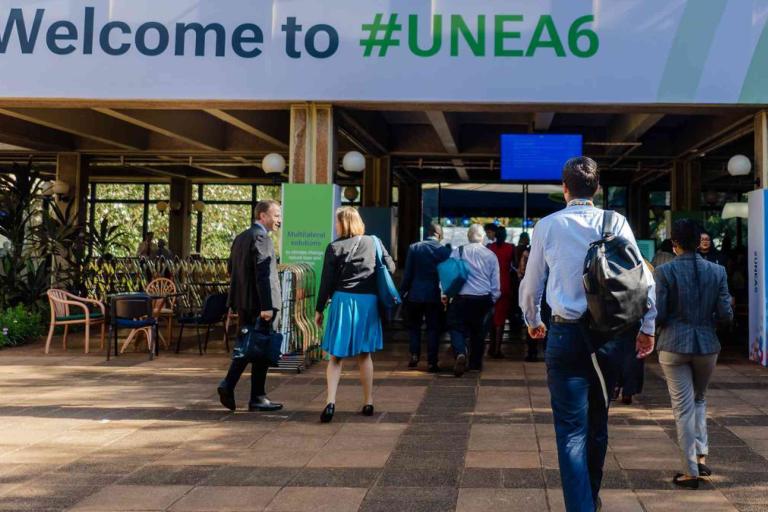A greener, more resilient planet

UN Environment Assembly calls for urgent multilateral actions and a forward-looking, risk-informed approach.
To address global environmental challenges the world needs effective multilateralism that translates ambitions into scalable solutions and promotes risk-informed innovation.
From 26 February to 1 March 2024, governments, international organisations, civil society and other stakeholders met in Nairobi for the (UNEA-6). Their goal: to agree on meaningful global environmental policy that will deepen multilateralism and drive action.
As we return to our offices after the closing of UNEA-6, the UNDRR participants are reinvigorated, inspired to energize existing partnerships and seek out novel alliances that will foster synergies, coherence and complementarity between multilateral environmental agreements and the Sendai Framework for Disaster Risk Reduction. Through partnerships and collaboration we can strive for a more sustainable, equitable and resilient future for present and future generations, for people and planet.
To achieve progress, we need to place risk-informed decision-making at the heart of environmental action and make nature conservation an integral part of disaster risk reduction.
Environmental multilateralism and disaster risk reduction
Through our deliberations, the UNEA-6 participants recognized that we must overcome single-issue approaches, determine entry-points to align common priorities, and foster resilience-thinking across all areas of environmental governance.
The Assembly adopted a ministerial declaration and various resolutions that call for actions in a number of critical areas that involve disaster risk reduction, surfacing a number of synergies with goals of the Sendai Framework for Disaster Risk Reduction:
- Climate-resilient development, including the protection of people and ecosystems from increasingly frequent and intense disasters, must reduce the vulnerability of those left farthest behind and the application of whole-of-society approaches. Comprehensive disaster and climate risk management can support countries in these efforts.
- Mainstreaming of environmental challenges across disaster risk reduction policies and actions supports coherent and synergistic national policymaking and implementation. This is critical to mitigate and prevent negative impacts from disasters – both for people and the environment. Disaster risk reduction must reflect environmental challenges as well as solutions found in nature, in the policies adopted and in the measures chosen to address hazards, strengthen societal resilience and ensure the implementation of build back better and greener approaches. Equally important is the use of risk-information and resilience in environmental agreements, frameworks, policies and plans – including those related to biodiversity, water and plastic pollution.
- Water-related risks and drought resilience permeate all sectors. To address water-related risks, risk information must be considered in water resources management for increased disaster preparedness and strengthened disaster risk reduction – including through resilient water infrastructure and nature-based solutions for water-related risks. Water challenges need to be addressed with a focus on situations of water scarcity and drought. As drought is a slow-onset disaster, it is paramount to take more proactive approaches to managing droughts, reducing vulnerabilities and enhancing resilience.
- Early warning systems provide important data across multiple hazards for increased preparedness, early action, and anticipatory action. Environmental hazards need to be included in this analysis to give a more complete understanding of the risk landscape. The call from the UN Secretary-General for early warnings for all is an important step in this direction.
Two top priorities for a multilateral approach to risk-informed environmental action
Building on the momentum gathered at UNEA-6, we must now translate the intentions and calls to action into concrete actions for impact. For UNDRR, this means two specific priortities to accelerate multilateral actions:
- With disasters affecting all parts of society, we are stepping up our work on overcoming siloes and single-issue approaches. We advocate that countries promote a culture of disaster prevention and resilience across all areas of sustainable development. A coherent approach requires the alignment of common priorities, and creates opportunities to save costs, minimize duplication and accelerate mutual benefits.
- Commitment to a reinvigorated multilateralism hinges on a forward-looking and risk-informed approach that stimulates investments and innovation. This is why we support the implementation of nature-based solutions, early warning systems, and the loss and damage mechanism as important tools to drive such innovation, help track progress and identify areas for improvement towards more prevention-oriented actions.
Upcoming multilateral processes in 2024 will provide additional opportunities for collective action to increase integration – linking multilateral environmental agreements with the Sendai Framework for Disaster Risk Reduction and other important agendas and processes.


